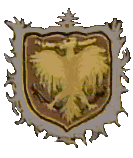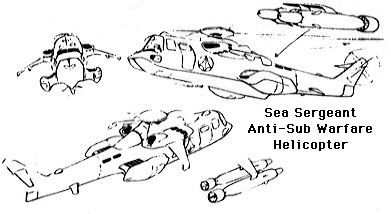

Designation:EH/Sikorsky 303 Sea Sergeant ASW Helicopter
|

|

|
|||

|
|||||
| Total Length: | 25.3 m |
| Total Height: | 4.5 m |
| Total Width: | 6.3 m |
| Total Rotor span: | 21.2 m |
| Total Dry Weight: | 13.2 metric tons |
The skin of the Sea/Cargo Sergeant is composed of treated magnesium plate. The skin provides fair protection against small arms fire, and good protection against small grenade and shell fragments, though it is especially vulnerable to incendiary weapons.
The Navy of the pre-holocaust UNDF was equipped with much the same hardware as their national ancestors and contemporaries, as the use of expensive Robotechnology was at first limited to combat units more likely to engage the alien enemy, such as the orbital forces and the Veritech squadrons. However, this did not mean that these divisions were under-appreciated, as at least a semblance of internal peace was required for the UNDF to function effectively. Hence the material used by the UN Army and Navy groups was always top-quality, and thus better than most likely opponents, such as the Anti-Unification League.
The standard large shipboard helicopter, used for all kinds of work ranging from search and rescue to sub-hunting was the European Helicopters/Sikorsky Sea Sergeant. With a hull form reminiscent of the venerable Sea King and an advanced version of the systems used in the EH 101 this helicopter was the unchallenged winner of the UNDF competition for such an helicopter. Sea Sergeants could be found on most UNDF ships and also on many land bases. Ironically, this design was the first Earth-side combat unit in contact with the invading Zentraedi, when two Sea Sergeant helicopters were dispatched to investigate off the coast of Macross Island for several submerged alien contacts, with tragic results for the crews.
Used extensively before and after the Holocaust, the design was later adopted by the Southern Cross Navy, which continued to use it (with regular electronic and engine updates) until the Invid invasion. Examples of the helicopter, or of its land-based Cargo Sergeant transport variant, could still be found in human resistance and other groups during and after the Invid occupation.
Return to UNDF Aircraft Index
Go to Robotech Reference Guide Home Page.
Robotech (R) is the property of Harmony Gold. This document is in no way intended to infringe upon their rights.
Content by Pieter Thomassen and Peter Walker